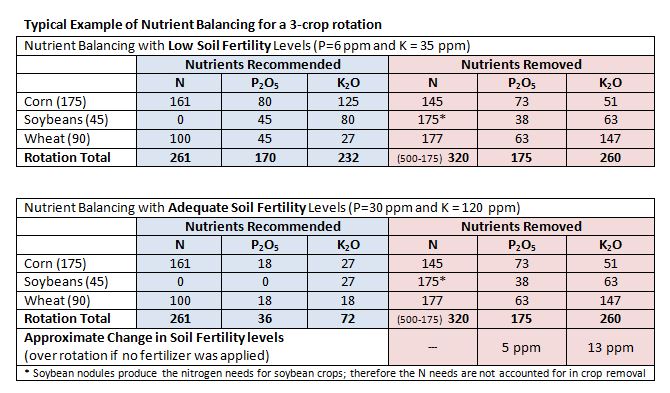A recent news article (Ontario Watershed study shows over application of phosphorus) phosphorus is being over applied by Ontario farmers. The research quoted in the article gives no indication of soil fertility levels, and gives little information on soybeans in the rotation, all of which are essential to nutrient balancing. If growers apply 50 lbs of phosphorus (P) to both corn and wheat, then 40% (the amount of over application indicated in the article) would represent 40 lbs P205. This amount of “over application” would roughly equate to a 1 ppm soil test increase in soil test phosphorus levels. If a grower is trying to build phosphorus soil test levels, due to inherently low soil test P, this application would be well advised.
Nutrient balancing needs to compare the amount of nutrients applied, to how much is removed, over the entire crop rotation. In order to balance nutrients, soil fertility levels, yield goals and crop needs are required information to determine proper application rates. Corn and wheat have greater response to applied nutrients (especially seed-placed phosphorus), and applying to crop needs allows producers to follow the principles of right rate, right time, right source and right place.
In Ontario a general guideline is that it takes approximately 35 lbs of P2O5 to increase soil test levels by 1 ppm and it takes about 20 lbs of K2O to increase potassium (K) levels by 1 ppm. There are variations based on soil characteristics, however these amounts give producers an indication of how closely they are increasing or decreasing soil fertility in their fields.
In nutrient management planning, crop needs/recommendations are always the first priority, especially on soils with low fertility levels. For livestock farms with adequate soil fertility levels and where nutrient recommendations are low, manure application rates are set to match the nutrients removed by a crop. Manure is most often applied to meet the nutrient needs of a corn crop, followed by wheat and forage crops. Manure and fertilizer application does not often occur on a soybean crop since soybeans do not make efficient use of the manure nitrogen (N) (the root nodules supply the plant’s N needs), however the soybean crop removes significant nutrients from the field. Manure nutrient management plans generally have manure and/or commercial fertilizer applied 1 or 2 times in the rotation to meet the crop needs for a full rotation of crops. Therefore if 40% more phosphorus is applied to 1 crop in the rotation, it may be providing nutrients for the crop year where no nutrients are applied. From an environmental perspective this means manure and fertilizer are applied less frequently and from an economic perspective it allows a grower to follow 4R principals that maximize economic nutrient efficiency.
Table 1 shows the crop needs and crop nutrient removal for a corn-soybean-wheat rotation with average yield goals. In one scenario, the soil fertility levels are low, where nutrient needs are higher than crop removal, while in the second scenario the soil fertility levels are adequate and fertilizer needs are lower – often met with a commercial fertilizer starter.

The nutrients recommended over the crop rotation will help ensure maximum economic yields, while the nutrients removed give an indication of how quickly fertility levels will decrease. Soil testing gives an indication of nutrients available for a crop, and how big the “soil bank account” of nutrients is. Responsible crop production should aim to maintain a reasonable (medium soil test) amount of nutrients in the soil. Healthy soils with good infiltration capacity, good aggregate stability and diverse microbial populations are the best defense for minimizing environmental impact from nutrient loss.
Human nutrition is important to overall health and the Canada Food Guide gives suggested best practices. Similarly, food production requires good crop nutrition. Nutrient Management planning tools help Ontario producers to manage and apply nutrients based on soil fertility levels, crop rotation and crop needs accounting for field conditions that could impact environment. NMAN software allow producers to see what impact decisions such as timing of application or application rate could impact nutrient availability. Application rates should be targeted to crop needs, and maintenance of reasonable soil fertility levels for healthy, productive soils.